Nowadays, technology plays a critical role in business communication. Team communication tools provide a hub for chat, document sharing and collaboration, task management, and voice and video communication, enhancing how team members communicate and work together.
But with so many different types of communication software, you’re sure to have questions. Which tool is right for your team? What should you look for? What are the benefits?
Below, we’ll lay it all out. So without further ado, let’s begin.
Overview of the Best 10 Tools for Team Communication
Let me first outline the purpose and best features of all team tools for effective communication that we’re going to discuss.
| Tool | Best for |
| Brosix | Robust, real-time internal communication and team collaboration with strong administrative control options. Suitable for in-office or remote teams of all sizes and kinds. |
| Chanty | Unlimited messaging history and AI-powered tool at startup-friendly prices. Suitable for small to medium-sized teams. |
| Slack | Extensive integrations (2,000+) and customizable sidebar and themes. A popular choice for its smooth UX and broad feature set. |
| Flock | Budget-friendly team chat option with a built-in task manager and 60 integrations. Targeting Slack’s market with more competitive prices. |
| Ryver | Combining communication with project management on one platform. Flat-rate pricing for unlimited users, suitable for task-oriented teams. |
| Microsoft Teams | Collaboration software on top Office 365 products. Ideal for large enterprises and Microsoft users. |
| Troop Messenger | Cost-effective team communication software with features like conversation flagging and self-destructing burnout chats. Suitable for budget-conscious teams. |
| Discord | Rich voice capabilities, screen sharing, and a video conferencing tool. Originally for gamers, but it has gained popularity in the business world. |
| Workplace from Meta | Familiar UX with features like live streaming of company events. Suitable for teams comfortable with Facebook’s interface. |
| Fleep | Core chat capabilities with the ability to chat with users outside your organization. Task manager and integrations are available. |
The 10 Best Team Communication Tools: An In-Depth Look
You may ask which tool provides a way for teams to increase communication. To answer this question, I took some time to curate this list and offer you 10 options to choose from.
1. Brosix
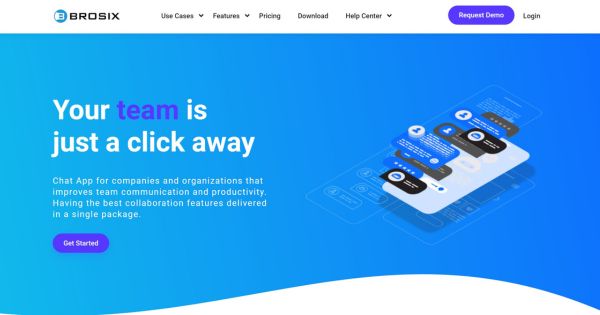
Brosix is built for teams of all sizes and kinds. It is a highly capable, secure, and customizable communication tool for teams. Chat instantaneously via one-to-one text messages, tailor chat rooms to meet specific group requirements, and make crystal clear voice and video calls all over fully encrypted, peer-to-peer channels on a private team network.
Our rich collaboration features and administrative controls allow you to fully customize and manage the team communication experience. Delegate features and tools on a user or team basis, tailor shared chat spaces and contact lists, authorize multiple team admins, and more.
With Brosix, you can also take advantage of:
- Unlimited-size file transfers
- Searchable chat histories
- Virtual whiteboard conferences
- Screen sharing with remote desktop control
- Instant screenshots
- The ability to broadcast messages to targeted audiences
“In our experience, working with clients in the healthcare sector, having HIPAA-compliant communication tools has been a non-negotiable requirement. Brosix provides peace of mind that our clients’ data is secure and meets all regulatory standards.” — Gianluca Ferruggia, General Manager, DesignRushBrosix pricing: Free team communication and modest admin control with Startup; $4 user/month for Business; $6 user/month for Premium gets you full control and customization of your team network.
Pros and cons
| Brosix Pros | Brosix Cons |
| Comprehensive control options allow administrators to manage permissions and user access effectively | The interface could be improved and modernized, according to some users. |
| Encrypted communication channels | Users sometimes experience synchronization problems, which can disrupt the flow of communication. |
| Provides detailed logs of user activities, enhancing security and accountability within the platform | Offers fewer integrations with other software and tools |
Available on: Windows, macOS, iOS, Android, Linux, Web
User ratings:
- Trustpilot 4.3 (Stars) from 14 people
- Capterra 4.6 (Stars) from 71 people
- G2 4.7 (Stars) from 44 people
The verdict: Combining robust, real-time communication and collaboration tools, powerful administrative control options, and best-in-class security, Brosix improves the quality and productivity of teamwork while safeguarding data and information. Take it for a spin and see how it can improve your team’s communication.
2. Chanty
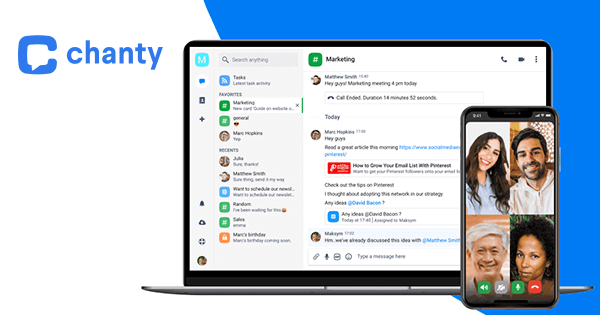
One of the newest team communication apps here, Chanty has made a name for itself by offering unlimited messaging history and AI-powered tools at startup-friendly prices. Chat one-to-one or in public and private channels. For good measure, Chanty throws in voice and video calls, file sharing, screen sharing, and a hub to organize tasks and conversations.
One of Chanty’s distinctive features is its Teambook, which provides a simple way to organize tasks, messages, links, and files.
Chanty pricing: Free for up to 5 members; Paid plans start at $3 per user/month.
Pros and cons
| Chanty Pros | Chanty Cons |
| Enhances user experience by providing AI-powered search results and recommendations. | Communications are not end-to-end encrypted |
| Keeps track of conversations and tasks, ensuring nothing falls through the cracks and improving productivity. | Some users find the interface overcrowded, which can make navigation and usability challenging. |
| Automated workflows through Trello, Mailchimp, and Zapier integrations |
Available on: Windows, macOS, iOS, Android, Web
User ratings:
- Trustpilot 4.4 (Stars) from 10 people
- Capterra 4.7 (Stars) from 34 people
- G2 4.5 (Stars) from 41 people
The verdict: Customization options are limited, and some features and integrations still aren’t available, but Chanty’s upfront about that. That said, the free unlimited messaging history is an obvious slight to Slack. Chanty is an up-and-comer worth keeping an eye on.
3. Slack
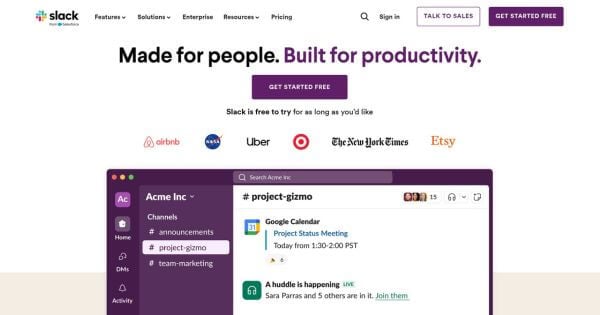
No doubt, this is the app you’ve probably heard of. While Slack provides the features you need to communicate with team members—instant messaging, voice and video calls, file transfers, and screen sharing—integrations are its bread and butter, and Slack delivers more than two thousand of them.
Slack can integrate RSS feeds, allowing users to stay updated with news and information directly within the app. What’s more, you can set up keyword alerts to stay informed about important topics or conversations.
“Slack has transformed our internal communication, increasing speed and clarity. For example, our marketing team employs separate channels for each campaign. This strategy enables concentrated discussions, timely feedback, and efficient project management. As a result, campaign rollouts have been accelerated, and team collaboration has improved.” — Phil Strazzulla, Founder, SelectSoftware Reviews
Slack pricing: Slack’s free option limits you to 90 days of shared files and message history access and 10 integrations; Pro for $7.25 user/month; Business + for $12.50 user/month (both for annual subscriptions)
Pros and cons
| Slack Pros | Slack Cons |
| Offers over 2,000 integration options | Possible information overload, with messages and notifications potentially distracting users |
| Slack bots can remind you of tasks and messages | Relies on a stable internet connection, which can be problematic for those facing network issues |
| Users can personalize their workspace by customizing the sidebar and theme | The paid plans can be costly for some users |
Available on: Windows, macOS, iOS, Android, Linux, Web
User ratings:
- Trustpilot 2.9 (Stars) from 278 people
- Capterra 4.7 (Stars) from 23,230 people
- G2 4.5 (Stars) from 32,668 people
The verdict: More than 32 million daily active users will attest that Slack is a worthy team communication tool. It’s got a hip user experience (UX) and more integrations than anyone else.
But Slack’s price point puts it out of reach for many small to mid-sized businesses and startups. Slack’s powerful integrations also mean that many of its capabilities are the result of other tools and technologies. What’s more, questions have been raised surrounding Slack’s handling of user data as well as the threat that third-party apps can pose.
4. Flock

Born in India, now Flock is aiming at Slack. This team communication tool provides one-on-one and group chat, audio and video calls, a task manager, and around 60 integrations.
Flock pricing: $4.50 per user/month for screen sharing, unlimited messaging history, and 10GB storage per user; The enterprise plan requires contacting sales; The freebie plan limits you to 10K message history.
Pros and cons
| Flock Pros | Flock Cons |
| Built-in task management allows users to manage tasks directly within the platform | Some users may find Flock’s features limited compared to alternatives like Slack or Microsoft Teams |
| Auto-generated mailing lists, shared to-do lists, and polls | The audio and video quality can sometimes be distorted during video chats due to poor internet connectivity |
| Integrates with over 60 apps, enabling users to connect various tools and services to enhance their workflow | The free version of Flock has a 10,000-message history limit |
| Users can invite guests to join the platform, facilitating collaboration with external partners |
Available on: Windows, macOS, iOS, Android, Linux, Web
User ratings:
- Trustpilot 2.7 (Stars) from 6 people
- Capterra 4.5 (Stars) from 342 people
- G2 4.4 (Stars) from 268 people
The verdict: Flock’s interface isn’t the most user-friendly, and there are limited customization options. That said, it’s an affordable option that claims to be faster than Slack.
5. Ryver
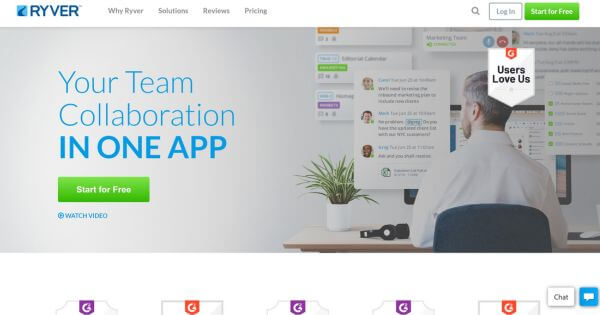
Ryver is a communication tool for teams that ups the ante by providing task management on the same platform. Communication happens in direct messages, open forums, or private groups, all of which can be turned into tasks and tracked on a Kanban board.
Ryver pricing: Plans from $69 per month for up to twelve users; $129 per month for up to 30 users; $4/user for over 30 participants; Enterprise plan upon request. There’s no freemium plan, just a 14-day free trial.
Pros and cons
| Ryver Pros | Ryver Cons |
| Voice and video calls, screen sharing, and unlimited integrations through Zapier | Ryver’s user interface is criticized for being unintuitive |
| Users can set reminders to follow up on messages | Lacks the level of customization available in other team messaging apps |
| Social media, news, and RSS-feed streaming | Ryver does not offer a free plan, which can be a barrier for small teams or those on a tight budget |
| Chat, task management, and automated workflows on one platform |
Available on: Windows, macOS, iOS, Android, Web
User ratings:
- Trustpilot 3.7 (Stars) from 1 person
- Capterra 4.4 (Stars) from 43 people
- G2 4.4 (Stars) from 153 people
The verdict: Ryver bucks the trend by charging a flat rate for unlimited users, team communication, and task management on one platform.
Bear in mind that customization options are limited, and there’s no free plan. And if your team relies on Zapier integrations, get ready to pay up.
6. Microsoft Teams

Part of the Microsoft 365 and Office 365 packages, Teams is Microsoft’s communication tool geared toward large enterprises. Aside from the usual chat, audio and video calls, and screen sharing, Teams stands out for its deep integration with the Office 365 range of tools, making it an effective team collaboration tool.
Microsoft Teams pricing: Business Essentials for $4 per user/month; Business Basic for $6 per user/month; Business Standard for $12.50 per user/month; All plans have a free trial of one month.
Pros and cons
| Microsoft Teams Pros | Microsoft Teams Cons |
| Seamlessly integrates with Microsoft Office 365, allowing users to collaborate on documents | The deep integration with other Microsoft products can be a limitation for teams that use non-Microsoft tools or services |
| Enables real-time collaboration on Office documents, enhancing productivity and teamwork | Limited customization options, which can make it difficult for teams to tailor the platform to their specific needs |
| Offers in-messaging formatting similar to Microsoft Word | Transitioning from Outlook to Teams can be challenging for users accustomed to Outlook’s features and workflows |
| Utilizes artificial intelligence (AI) to enhance user experience |
Available on: Windows, macOS, iOS, Android, Web
User ratings:
- Trustpilot 1.4 (Stars) from 174 people
- Capterra 4.5 (Stars) from 9,468 people
- G2 4.3 (Stars) from 15,040 people
The verdict: For collaboration on top of Office 365 products, Teams can’t be beaten. The same goes if you’re an Office 365 or Microsoft 365 account holder or just happen to be a fan of Microsoft in general. Just have your patience ready when deploying Teams, as well as your credit card. You’ll need a Microsoft account just to access Teams.
7. Troop Messenger
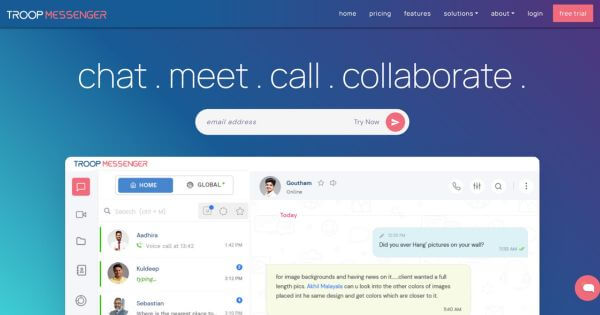
Troop’s platform for teams facilitates one-on-one and group communication, as well as audio and video calling and file-sharing, but at an affordable price. Enterprise plans get you message-flagging capabilities, burnout chats, data usage analytics, and the option to self-host.
“We were concerned about how information sharing would work among remote employees using personal devices. We wanted a more secure channel which would prevent secure sensitive conversations.
Troop Messenger was a perfect fit. Its Burnout feature with time-limited chats was a fitting solution for our problem.” — Jason Hennessey, Founder and CEO, Hennessey Digital
Troop Messenger pricing: Paid plans start at $2.50 per user/month
Pros and cons
| Troop Messenger Pros | Troop Messenger Cons |
| Allows users to flag important conversations for easy reference and follow-up | Some users have reported occasional issues with the app loading |
| Offers self-destructing messages for sensitive or temporary communications | Limited file sharing capabilities, with image file size limits of up to 5 MB and video file size limits of up to 20 MB |
| Provides unlimited message storage, allowing users to access their entire conversation history without restrictions. | The preview of text files can sometimes take longer to open |
Available on: iOS, Android, Windows, macOS, Linux
User ratings:
- Trustpilot 4.4 (Stars) from 13 people
- Capterra 4.8 (Stars) from 16 people
- G2 4.6 (Stars) from 74 people
The verdict: Troop doesn’t offer a free communication tool but for just a buck a month, who needs it? Troop is great value for money, but collaboration tools are basically limited to screen sharing.
8. Discord

Originally a communication app for gamers, Discord has gained fame in the business world for its rich voice capabilities. On Discord, voice communication is always on, and the ‘Push to Talk’ feature allows you to join a conversation just like a walkie-talkie.
Discord pricing: Discord’s freemium version offers core functionality; Nitro Basic for $2.99; Nitro for $9.99/month for bigger file uploads, higher-quality screen resolution, and animated avatars and emojis.
Pros and cons
| Discord Pros | Discord Cons |
| Screen-sharing, video conferencing, and file-sharing capabilities | Users should be careful when sharing personal information, especially on public servers |
| Ability to assign roles and permissions to any member of a channel | Discord can be overwhelming for new users due to its many features and customization options |
| Combines multiple workspaces into a single interface, simplifying navigation and management | Discord’s moderation tools are not as advanced as those on other platforms yet |
Available on: Windows, macOS, iOS, Android, Linux, Web
User ratings:
- Trustpilot 1.5 (Stars) from 1,061 people
- Capterra 4.7 (Stars) from 424 people
The verdict: As freeware (software that’s available for free) with all your workspaces on one interface, Discord’s a highly usable tool and an attractive option for businesses. Concerns have been raised around security, though. As the platform has grown in popularity, cybercriminals have been found lurking on it.
9. Workplace from Meta
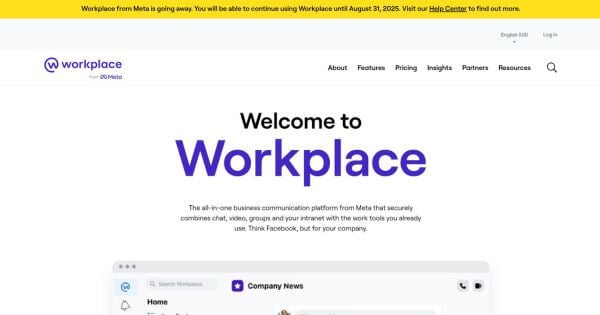
No longer just a social media giant, these days Meta—the company behind Facebook, Instagram, and WhatsApp—is targeting workplaces. Besides direct and group team messaging, the app gets you voice and video calls, monitoring tools for IT teams, admin controls, and some integrations.
Workplace from Meta pricing: Paid plans start at $4 per user/month.
Pros and cons
| Workplace from Meta Pros | Workplace from Meta Cons |
| The live stream option facilitates engaging company-wide events and instant feedback | Certain features have recurring bugs, such as issues with notification settings and involuntary group additions |
| Ability to invite customers or teams from outside the organization | The platform’s numerous functionalities can be distracting |
| Unite chat and collaborate with Groups | Users report delays in notifications across different devices |
| Facebook-familiar team communication, collaboration, and culture |
Available on: Windows, macOS, iOS, Android, Web
User ratings:
- Trustpilot 3.2 (Stars) from 2 people
- Capterra 4.4 (Stars) from 1,337 people
- G2 4.0 (Stars) from 1,714 people
The verdict: Facebook is banking on a familiar UX with Workplace. That means there’s a newsfeed, personal pages, posts, comments, and likes. There’s something to be said for familiarity and ease of use, especially when trying to get your team on board. But at what cost?
Over the years, Facebook has scraped data from Android users, provided millions of users’ personal data to political consulting firms, and even paid teenagers to try apps, which then allowed Facebook to harvest their private data. Hardly a sparkling reputation.
Furthermore, Meta recently announced that they are completely shutting down Workplace by June 2026.
If you’re looking for a user-friendly team communication tool that you can trust, try Brosix. Our platform is easy to use, and we pay serious attention to the security of user data and information.
10. Fleep
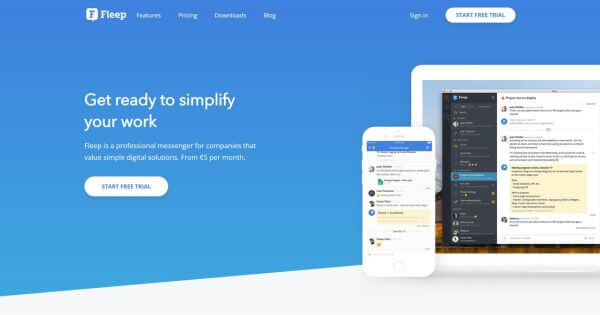
With Fleep, you can chat with other Fleep users and teams outside your organization. You don’t get collaboration tools, but Fleep does offer task management and 20 or so integrations like Trello, Jira, Google Drive, and others. Voice and video calls take place through Whereby.
Fleep pricing: Free two-week trial period; $5 per user per month gets you full control over team communication and conversations; Custom price for the Enterprise plan
Pros and cons
| Fleep Pros | Fleep Cons |
| Unlimited messaging history | Improper configuration can lead to security and privacy issues |
| Allows users to send emails directly within the application | External service is required for voice and video calls |
| Native task management features | Limited group conversations for basic users |
Available on: Windows, macOS, iOS, Android, Web, Linux
User ratings:
- Capterra 4.7 (Stars) from 34 people
- G2 4.4 (Stars) from 28 people
The verdict: As far as team communication tools go, Fleep delivers the core chat capabilities you’d expect. If you’re looking for more in the way of collaboration tools or integrations, you’ll need to look elsewhere. What’s more, there’s no native voice or video calling. That happens through Whereby, a browser-based app that’s limited to 12 participants and a handful of browsers.
[highlight_block title=”Now that you’re in the know, level up your team communication skills with these smart ideas for improving team communication at work.” link1=”https://www.brosix.com/blog/improve-team-communication/” link2=”” link3=”” ]
How to Choose the Best Communication Tools for Teams?
With so many apps and tools for team communication, how do you choose the right one? Luckily, there are some common criteria to look for when you’re trying out new communication software.
- Text-based communication: Effective team communication tools should provide text-based, voice, and video communication on a single platform. Integration with a project management tool is recommended.
- Private team network: The best team communication app should be tailored to the team, with some platforms allowing outsiders like freelancers or clients to join.
- Security and privacy: Ensure there is encryption over peer-to-peer channels and use a strong anti-virus and malware program.
- Customization and control: A communication tool should be tailored to meet individual team or business needs. Platforms should allow for custom chat spaces, handpicking administrators, and managing the space from contact lists to individual data security levels.
- Collaboration tools: Consider what your team needs for productivity, from basic chat capabilities to file sharing, screen sharing, instant screenshots, and virtual whiteboards.
- Low learning curve: A good communication app should be easy to use and deploy, ensuring both techies and non-tech types can find the platform and its features.
- Cross-functionality: The primary job of a communication tool is to keep everyone communicating productively, so it should be optimized across various devices, and operating systems, such as Windows and Linux, browsers, and mobile and desktop platforms.
The Takeaway
When it comes to choosing the right communication tool for your team, there’s no one-size-fits-all formula.
First, evaluate the unique needs of your team members. Then compare them against the features you need to boost productivity and the benefits you most want to realize. Don’t hesitate to test drive a few different internal communication tools. Many offer free versions or trials, which is a great way to evaluate their user-friendliness and core functionalities.
If you’re having trouble making up your mind, give Brosix a look. It’s an all-in-one solution that’s built to improve how teams stay connected and collaborate effectively.
